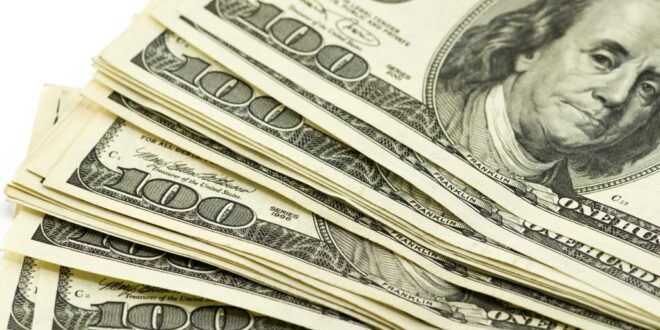De-dollarization could become a reality as a BRICS alternative to the dollar could enjoy high prospects for success, said a former White House adviser.
A report by Business Insider — The dollar’s dominance would face a threat unlike any other from a BRICS currency, former White House economist says, April 26, 2023 — said:
Joseph Sullivan, who served as a staff economist at the White House Council of Economic Advisers during the Trump administration, wrote in Foreign Policy that a currency issued by Brazil, Russia, India, China and South Africa would pose a unique threat to the dollar’s dominance.
“It would be like a new union of up-and-coming discontents who, on the scale of GDP, now collectively outweigh not only the reigning hegemon, the United States, but the entire G-7 weight class put together,” he said in a column published on Monday.
The report said:
In recent months, discourse about de-dollarization has flourished. That is as sanctions against Russia have exposed the danger of overdependence on the dollar, paired with growing efforts to bolster other currencies, especially the Chinese yuan.
And Brazil’s president recently reminded the world about plans for a BRICS currency based on a basket of member currencies.
A notional BRICS currency would carry key advantages over existing alternatives like bilateral deals that still result in proceeds being parked in dollar assets and have limited use with other countries, Sullivan said.
“The BRICS would also be poised to achieve a level of self-sufficiency in international trade that has eluded the world’s other currency unions,” he said. “Because a BRICS currency union — unlike any before it — would not be among countries united by shared territorial borders, its members would likely be able to produce a wider range of goods than any existing monetary union.”
Non-member countries would also have reason to use a BRICS currency because each member’s economy is large enough in their respective regions to make them sought-after partners, Sullivan said.
In addition to eroding dollar dominance in trade, a BRICS currency could weaken the greenback’s status as a reserve currency.
BRICS governments could induce their own households and companies to buy assets in the new currency with their savings and “effectively coerce and subsidize the market into existence,” he added.
The Business Insider report said:
Sullivan also noted that it would not spell the end to the dollar’s reign — which still accounts for 84.3% of cross-border transactions — but possibly contribute to a multi-polar regime.
In fact, some decline in the dollar’s strength could be a good thing, he writes. At the moment, the greenback’s high price costs the U.S. jobs and lowers exports.
“Either way, the dollar’s reign is not likely to end overnight –but a [BRICS currency] would begin the slow erosion of its dominance,” he said.
Gold Leading Revolt Against Dollar
Central banks around the world are shifting away from the US dollar and turning their attention to gold as a safe haven asset, the chairman of Rockefeller International, Ruchir Sharma, has said.
Prices for the commodity have surged 20% in the past six months, with demand coming not from “the usual suspect” such as large and small investors “seeking a hedge against inflation and low real interest rates,” but from “heavy buyers” like central banks, Sharma wrote in the Financial Times on Sunday.
According to the investment expert, regulators are sharply reducing their dollar holdings and seeking a safe alternative. Central banks now account for a record 33% of monthly global demand for gold and are ramping up gold-buying more than at any time since data began in 1950, Sharma added.
“The buying boom has helped push the price of gold to near-record levels and more than 50% higher than what models based on real interest rates would suggest,” he explained, adding that “clearly, something new is driving gold prices.”
Sharma pointed out that nine of the top ten central bank buyers are in the “developing world,” including Russia, India, and China.
“Not coincidentally, these three countries are in talks with Brazil and South Africa about creating a new currency to challenge the dollar,” Sharma noted.
He attributed the rush for the precious metal to increasing sanctions pressure exerted by the U.S. and its allies, with as many as 30% of nations facing international penalties — up from 10% in the early 1990s.
“Thus the oldest and most traditional of assets, gold, is now a vehicle of central bank revolt against the dollar,” Sharma argued.
Some countries began to seek alternatives after seeing Russian assets frozen abroad and the country cut off from the SWIFT global financial messaging system.
“Suddenly, it was clear that any nation could be a target,” Sharma wrote.
According to the expert, the U.S. saw sanctions as a “cost-free way to fight Russia,” but in reality the weaponization of the dollar has come at a cost for Washington as even allies such as Thailand and the Philippines have started to look for alternatives.
Yuan Overtakes Dollar In China’s Cross-Border Payments
Citing official data, a Reuters reported said on Wednesday:
China’s yuan surpassed the U.S. dollar to become the most-used currency in China’s cross-border transactions last month.
Cross-border payments and receipts in yuan surged from $434.5 billion in February to a record $549.9 billion in March, according to calculations by the outlet, based on data from the State Administration of Foreign Exchange.
The Chinese currency was used in 48.4% of all cross-border transactions, reflecting a trend of shifting away from the dollar, as well as Beijing’s efforts to promote the use of the yuan. The share of the greenback in China’s international settlements dropped from 48.6% in February to 46.7% last month.
The volume of cross-border transactions covers both current and capital accounts, the outlet said. Although the share of the yuan in global settlements is still relatively low, it has been steadily on the rise over the past several years.
China’s attempts to move away from the dollar in international trade have sped up against the backdrop of sweeping sanctions imposed by Western nations against Russia, a major global energy producer and exporter. Indian policymakers have also taken steps towards shifting away from the greenback to rubles and rupees in mutual trade with Moscow.
Russia has been boosting its use of alternative currencies in transactions since last year. Russian President Vladimir Putin has suggested that the Chinese yuan should be used more widely, not only in trade with China, but also in Russia’s transactions with countries in Africa and Latin America. The latest data from the Bank of Russia shows that the yuan has become a major player in Russia’s foreign trade.
Argentina Drops Dollar In Trade With China
Another media report said:
Argentina will aim to pay for the bulk of its monthly imports from China in yuan rather than U.S. dollars, Argentina’s Economy Minister Sergio Massa announced on Wednesday. Buenos Aires and Beijing signed a currency swap agreement last year, aimed at stemming the outflow of foreign currency from Argentina’s central bank.
China is currently Argentina’s second largest trade partner after Brazil, and the second biggest destination for Argentinian exports. Argentina’s total imports from China were around $13.5 billion in 2021, according to the UN database on international trade.
Massa said that Buenos Aires will pay the equivalent of $1 billion in yuan for Chinese goods and services this month, with $790 million of monthly imports paid for in yuan each month thereafter. The currency swap agreement, expanded and finalized earlier this year, also allows Argentinian exporters to make settlements in yuan or dollars, to help balance the flows of foreign currencies in the central bank.
On a visit to China earlier this month, Brazilian President Luiz Inacio Lula da Silva called on developing nations to move away from the U.S. dollar in favor of their own currencies. India is also working to use its own currency or yuan to settle trade with China, while Russia started to accept payments for its exports from a number of countries in rubles and Chinese yuan.
The dollar’s share in global reserves fell ten times faster last year than over the past two decades, the CEO of London-based asset management company Eurizon, Stephen Jen, recently told Bloomberg. The process has accelerated after other countries saw Russia’s US dollar and Euro-denominated assets frozen abroad and Moscow cut from the SWIFT global financial messaging system.
US Secretary of the Treasury Janet Yellen recently admitted that the role of the dollar as the world reserve currency could diminish due to Washington using its leverage over the global financial system to pursue its geopolitical goals through sanctions.
 Eurasia Press & News
Eurasia Press & News



